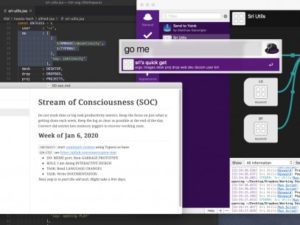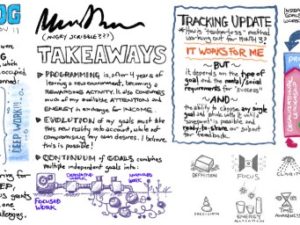(last edited on January 9, 2021 at 8:16 pm)
NOTE: This is the much-delayed Groundhog Day Resolution post for May 5, which fell on the Saturday I was at New England Give Camp camping out in Cambridge.
Oy, this month has completely gotten away from me in. First, I’ve been busy with multiple projects for clients, which is great. Secondly, I had obligations with New England Give Camp followed by my friend Alen getting married the following weekend. The one-two punch had sapped me of energy in a good way.
However, I’ve not been as focused on the “becoming a functional stationery maker” as I had wanted. While the process is moving along, I’m learning (again) just how long it takes to do something as conceptually simple as “ship some new pads of paper to Amazon.” So for this month’s Groundhog Day Resolution Review, I’m going to reflect on why that is.
What are Realistic Expectations?
While I have not been very organized this month, I have been focused. One huge advantage of switching from “Dave Seah: Information Graphic Designer” to “Dave Seah: Stationer” is that I can measure progress in terms of number of products available and number of units sold. However, I’ve fallen back on old habits, doing “what seems the most pressing” and trusting that it will get done. While I’m keeping track of hours spent, I’m not rigorously estimating hours; it’s sort of a Hakuna Matata approach to work. This may be the correct approach to take for creative work; my own sense of what is proper has been skewed by working in a way that fits design into an available timebox (with the assumption that it should also be awesome). When the fundamental questions about the job haven’t been decided, this is a terrible way to work. This attitude would not likely win me any glowing employee reviews at a “competitive” job, but I’ve dropped those expectations from myself and am as a result more relaxed.
At the same time, I’m learning to relax my expectations of how things SHOULD be, and am instead allowing a bit more exploration into my work. In the past, I would get very hung-up on being able to deliver exacting work on demand. To deliver exacting work requires equally exacting specification, and most of the time neither I or the client know exactly what those specifications will be. We each have a piece of the puzzle, and need to be willing to explore the solution space as a team, maintaining focus as we navigate through uncharted goat paths of creative opportunity. It’s tough work, but it doesn’t have to suck.
Realistically, I remind myself, it takes hundreds of hours to learn then create something that didn’t exist before. It’s easy, by comparison, to imagine what superlatives will describe it. I remember this, accept it, and try to keep moving while maintaining a positive attitude.
I have to admit, though, that it’s tough to accept how long it takes to make something from scratch, especially when I can SEE how that thing will fit into my master plan. It’s like waiting for cookies to bake when you haven’t eaten for an entire day. Patience is required, as each tiny step of the winning process is cultivated and put into action. To forget this is a precursor to frustration. If you can’t wait, buy something off the shelf and accept its limitations. Otherwise, keep a good attitude and make those tiny steps.
Here are some recent resources I’ve found useful in shaping this difficult balance of attitudes. All of them, I just noticed, were brought to my attention via my friend Colleen Wainwright, truth-seeking marketing maven:
- Back to Work, the podcast featuring Merlin “43Folders” Mann and Dan “5by5” Benjamin, covers subjects related to work and productivity. It’s something of a showcase for Merlin’s thinking on the subject, which is plentiful and insightful. Merlin, like me, isn’t particularly good at being productive, and he’s painfully aware of all the ways one can fall short because he’s done it. This gives his off-the-cuff analysis of root causes of various productivity pitfalls a cheerfully real credibility. Merlin is highly energetic and entertaining, too, which makes it a good listen even when they’re talking about Macintosh utilities for the umpteenth time. Worth a listen!
- Designers out there may remember Mike Monteiro’s F*ck You, Pay Me videotaped talk from last year, where he laid down the history and principles behind charging for his work. He’s expanded the material into a slim-but-mighty treatise called Design is a Job. A practical primer on charging for your design services, the book has renewed my confidence in the wisdom of saying NO when a potential project is not quite ripe for processing. Mike’s book isn’t exactly the guide for me, since I don’t really want to have a service-oriented business. However, I much appreciate the acerbic-yet-empathetic conviction in his voice, backed as it is by experience and admirable work. He speaks the truth as he sees it, without apology or malice. I also like his mildly-alarming manner of speech; if the Addams Family had a graphic designer locked up in the manor basement, it might be someone like Mike Monteiro. That’s a cheery-enough thought to get me up on a Monday and get the f*ck to work.
- Last week I received a review copy of Chris Guillebeau’s The $100 Startup: Reinvent the Way You Make a Living, Do What You Love, and Create a New Future. Chris Guillebeau is someone I’ve had my eye on for a while because he gets such good press from people I respect, yet occupies an Internet niche (self help) that I view with some suspicion. I attended one of his book tour stops in New Hampshire, and bought one of his art-related startup kits, looking for anything that smacked of bullshit. I didn’t find anything alarming that turned me off, nor did I find any whiff of hubris except in my own ungenerous attitude. The new book has swung my opinion of him hugely toward the positive. It is a humble book about being successful starting your own small-scale business. While it doesn’t paint a picture of just how hard things are, it does tell a lot of stories about people who did simple things to build a self-sustaining business that fit their personal desires and passions. The tone of the book is relaxed, factual, and conversational while incorporating ideas found in three of my other favorite reads in this area: the freedom-oriented aspects of The 4-Hour Work Week, the motivational aspects of Ignore Everybody, and business/marketing concepts of The Personal MBA. Chris’ secret to success appears to be his willingness to put in the long hours and think about people’s needs without the need to complain or expend energy showing off; he’s that guy who succeeds because he builds the best products he can without getting too wrapped up in the appearance-maintenance and personal angst that often comes with creativity. That’s really freakin’ fantastic.
The Product Refresh
Getting back to actual “Maker of Functional Stationery” work, I’m happy to report there has been progress made on the new version of the printed Emergent Task Planner pads. They are on their way to Amazon.com as I type.
The main goal of the product refresh is to reduce the price from $12.00 to $9.99, while increasing certain functional aspects of the package. To compensate for lowering the price, I’m reducing the page count from 75 to 50, but I’m incurring additional costs in terms of better cardstock + the inclusion of an instruction sheet. This makes the net cost of production of the new package actually about the same, so I’ll be making less money per-package than before. However, I want to test the theory of price elasticity, which says that given a change in price, there is a corresponding change in demand. The change is different for every product, and there are other variables involved, but this is a positive step toward understanding how “business” works.
On a philosophical note, I had positioned the printed ETP as a “premium” product so I could charge enough money to make a profit; it’s expensive to print and ship paper products. I’m finding that my natural desire for the ETP is not to sell it as a premium product, but instead to make a GOOD product available at the best price I can. We’ll see how this works out in practice. I may need a bit more deprogramming on this subject.
I’m not yet sure if I’ll continue to offer the 75-sheet pads at $12.00. Originally I was going to phase them out, but I think it might make sense to keep them as the “economy size” option. I’ll have to talk to my printer about this. I put a poll on my Facebook page, which is currently 50/50.
Juggling the Balance between Client and Personal Work
Both are important to me, and I think the major personal advance I’ve made is relaxing about where the time is going. In a sense, this is related to my recent epiphany about maintaining a good attitude toward whatever I’m doing. Before I was constantly worried that I was not working on personal success-building projects while doing client work, and when I was working on personal projects I worried that I wasn’t putting enough time into the client work. In the former situation, my fear was related to failing at finding my personal success. In the latter, I was bedeviled by my desire to please clients with great work. So many fears.
I don’t see the competition between client work and personal projects going away any time soon, so I need to deal with it and not get overwhelmed. I was initially excited about the possibility of product growth as I described in the “seeing the snowball grow” section of my last GHDR Review, I realized that it might take 2 years to get there given how long it was taking to fund and bootstrap new products. The StickyPads, which were a new product a couple months ago, are selling at 1/5th the rate of the Emergent Task Planner pads. This data underscores that not all products will be hits, and the ramp-up time will be correspondingly longer. At current rates of sales, it takes about 4 months to earn enough profit to fund another project.
But you know what? That’s fine. A positive attitude that is applied to both the personal work and client relations will pay off. I was reminded a couple weeks go that it’s critical to me to maintain strong communication channels with anyone I’m working with, as this boosts my attitude considerably. Working in a vacuum is one of the great displeasures of my life; I need smart, good-hearted people around me to thrive. From that, balance seems to come naturally.
On a different note, I now have so many communication threads out there that I need to figure out how to manage them. A few client threads have dropped, as they weren’t pressing or perhaps people are concerned about bothering me. I hope that’s not the case.
Concluding Thoughts
Also on my mind is how to keep the flame of my passions visible here on the blog, as this is the beacon that attracts new opportunity and collaborators. I have NOT been happy about the sporadic nature of my posting in the past two years, and the emphasis on business posts has skewed the content mix toward seriousness. I’m not going to go into that now, though, as this post is already getting super-long.
For the coming month, I have to finish a lot of client projects. This theoretically reduces the time I have to work on new products and related materials, but it also ensures that I have some income to do a few important home upgrades before Dad visits this fall.
What’s certain:
- New ETP Pad Package will Ship!
- Old Pad Package will remain!
- As time permits, will launch a new project. I have several to choose from.
What would be cool to have:
- Creating some new design-related procedures, so I can streamline client work further.
- Creating a better multi-task management system. There is a hole in my task management forms that I hadn’t noticed before.
- Finding some more creative partners, or people who would like to work for me in exchange for the experience of doing it.
What I want to avoid:
- Stressing out!
- Losing positive attitude.
- Disappointing clients and customers – that will have to be handled as it happens instead of worrying about it before I do the work.
- Falling out of the moment, and letting uncertainty-induced anxiety harsh my vibe.
We’ll see what happens!
Groundhog Day Resolution Posts for 2012
Here are other posts about Groundhog Day Resolutions for the 2012 season.





4 Comments
<>
Which has morphed into a lot of inside jokes and back slapping between Merlin and Dan, with quite a bit of repetition. Still I enjoy Merlin Mann’s Woody Allen-esque take on tech and productivity. However I only listened to the 1st half of the last episode, and may forgo future Back to Work episodes.
I really enjoy listening to David Allen and his staff discuss GTD tips and trick. Unfortunately, because it’s the boss and his staff, criticisms of the system are mostly glossed over.
Any other podcasts you find helpful/practical?
Avrum: I don’t listen to many podcasts. I listen to Back to Work mostly on long car trips, and am up to October 2011 or so. Largely I find Merlin’s take on things compatible within my own exploration, and I also enjoy all the joking around. The only other show I really listen to is Wait Wait Don’t Tell Me, because of the joking around with the news. Occasionally I’ll listen to Let’s Make Mistakes, and there used to be an illustration podcast I listened to before it poofed away. Sometimes I will listen to John Gruber on The Talk Show when I’m working, half-listening.
Price elasticity captures a snapshot in time. You’re selling items over time, not in an instant. The price actually changes the demand curve, so you can’t sell something at one price, sell at another price, and then know what the demand curve is. The act of selling it, and the act of changing the price, affect the demand curve. (I am reminded of quantum mechanics, where measuring something changes it so that you can’t measure everything you want to measure.)
Something to consider is a higher “regular” price and then putting things on “sale” often. The regular price is your signal of quality. You’re saying that this is a high quality product (I have the old pad and it is nice!) and it’s priced appropriately. The lower price is to get more sales. Also, there’s a price discrimination factor involved. People who are not price sensitive will pay the full price; people who are more price sensitive will wait for the sales.
Amit: Thanks for calling out my inaccurate understanding of what “price elasticity” means in economics terms. What I’m attempting to do is see how price affects demand, so I can see if there is any kind of change in demand. There’s a good chance I’ll learn something completely unexpected :)
History sensitivity is something that I think I’m not yet affected by. Comparative pricing would be more of an effect, if I were to guess.
I decided to set the retail price of the new pad to $12 and sell it for $9.99. The interesting thing is that there seems to be a run on the OLD pads, as they now look like a better value because there are more sheets.